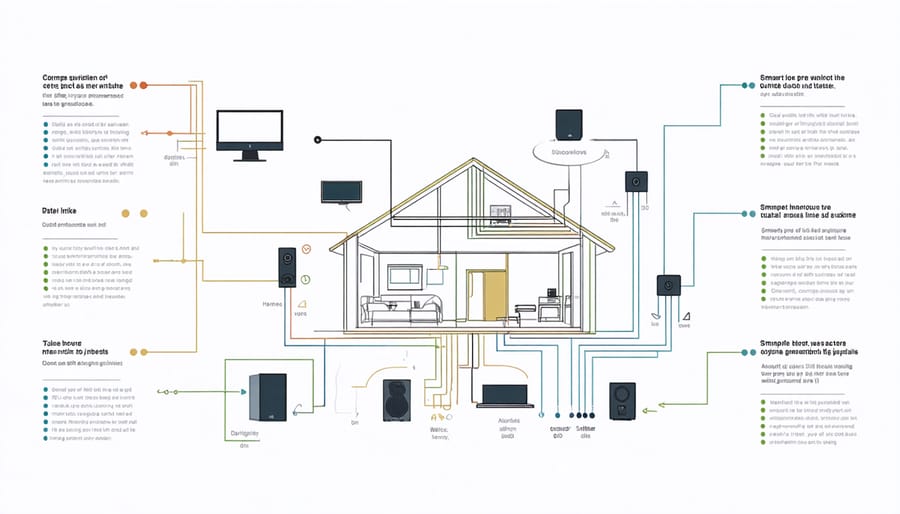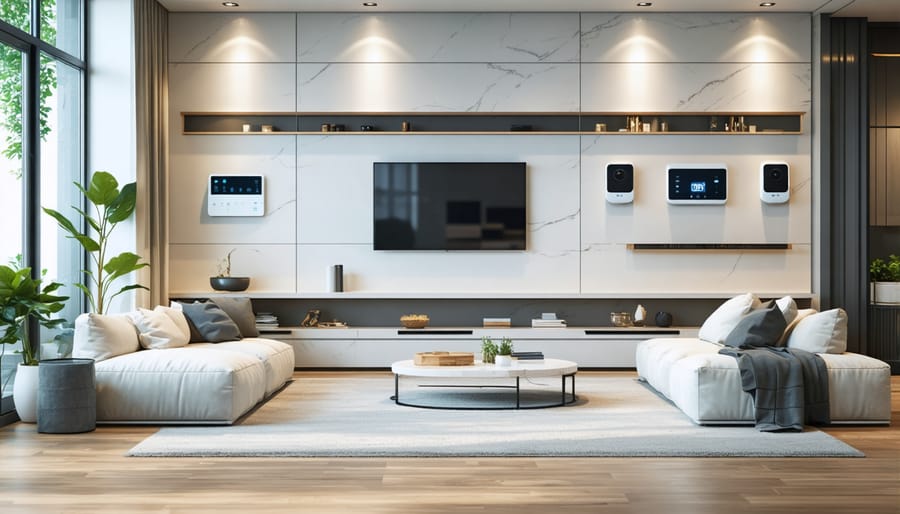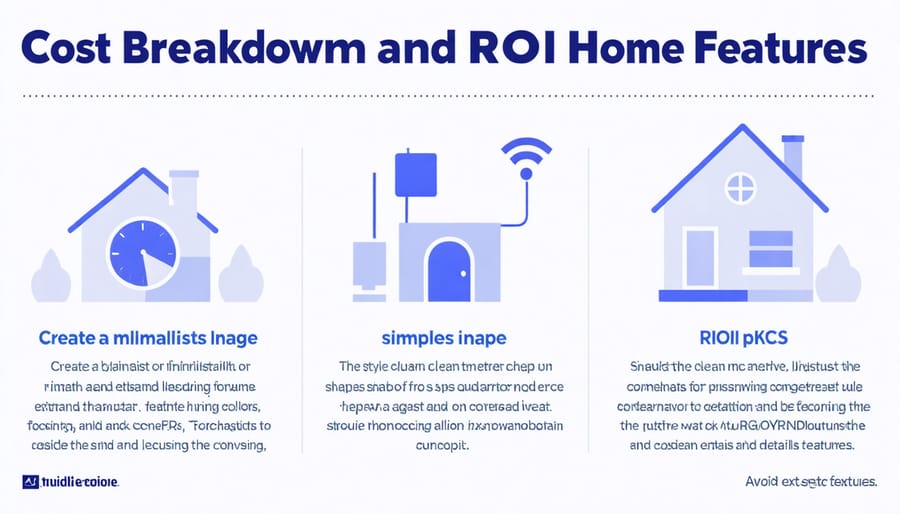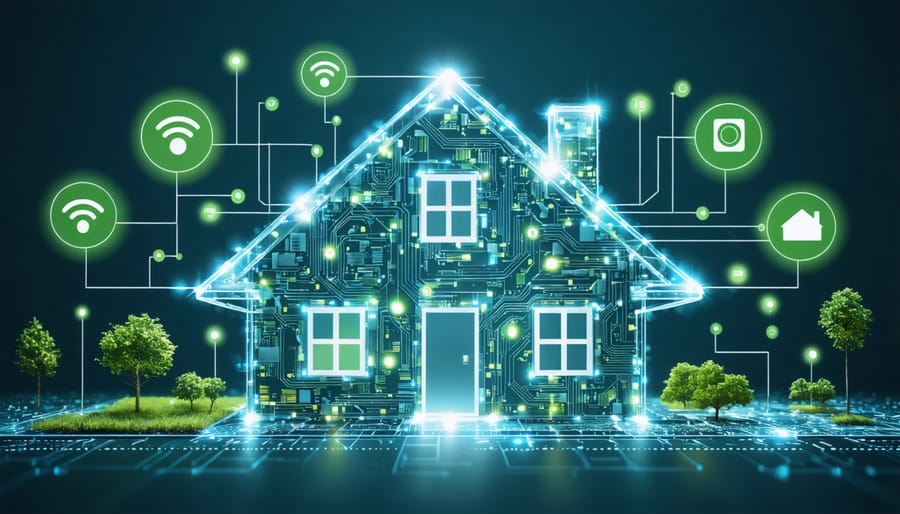The integration of smart home designs into modern construction demands a fundamental shift in how we approach building infrastructure. Today’s construction professionals must master the intricate balance between traditional building practices and cutting-edge automation systems. From the initial planning phase through final implementation, smart home construction requires specialized expertise in both structural engineering and digital technology integration.
The convergence of IoT devices, automated systems, and sustainable building practices has created unprecedented opportunities for construction firms to deliver homes that anticipate and respond to occupants’ needs. Advanced wiring systems, dedicated low-voltage pathways, and strategic sensor placement must now be considered alongside traditional construction elements. This integration demands careful coordination between electrical contractors, system integrators, and construction teams from the project’s inception.
As market demand for intelligent buildings continues to surge, construction professionals must develop comprehensive strategies for implementing scalable, future-proof smart home infrastructure. This includes designing flexible control systems, establishing robust network architectures, and ensuring seamless integration of various smart devices while maintaining the structural integrity and energy efficiency of the building envelope.
The Foundation of Smart Home Construction
Smart Wiring Architecture
A robust smart wiring architecture forms the backbone of any modern smart home installation. The system begins with a centralized distribution panel that houses both traditional electrical circuits and dedicated smart home wiring infrastructure. Category 6A or Category 7 ethernet cables serve as the primary data backbone, providing reliable high-speed connectivity throughout the structure.
Strategic placement of power outlets and data ports requires careful planning during the pre-construction phase. Industry best practices recommend installing conduit pathways to facilitate future upgrades and modifications. These pathways should include pull strings and adequate spacing to accommodate additional cabling needs.
Power distribution in smart homes incorporates dedicated circuits for critical smart systems and surge protection mechanisms. The implementation of structured wiring panels in each floor or zone enables efficient management of audio/visual components, security systems, and automation controls. Essential considerations include separate circuits for sensitive equipment and the integration of uninterruptible power supplies (UPS) for critical smart home components.
For optimal performance, professionals should implement a hierarchical wiring topology that separates high-voltage and low-voltage systems while maintaining proper interference shielding. This approach ensures reliable operation of both traditional electrical systems and smart home technologies.

Network Infrastructure Requirements
A robust network infrastructure forms the backbone of any smart home implementation. The foundation begins with enterprise-grade structured cabling, preferably Cat6a or Cat7, providing speeds up to 10Gbps and future-proofing capabilities. Strategic placement of wireless access points is essential, typically requiring one WAP per 1,500 square feet of living space to ensure comprehensive coverage.
The network design must incorporate a dedicated equipment room or cabinet housing core components: a high-performance router, managed PoE switch, and network security appliance. Minimum internet bandwidth requirements start at 300Mbps symmetrical, with fiber-optic connectivity preferred for optimal performance. Redundant internet connections should be considered for mission-critical smart systems.
Network segmentation is crucial, separating IoT devices from personal computing networks through VLANs. Include multiple runs of ethernet cables to key locations: entertainment areas, security camera positions, and smart device hubs. Conduit pathways should be installed during construction to facilitate future cable upgrades. Implementing a robust UniFi or similar enterprise-grade wireless system ensures reliable connectivity for mobile smart devices and seamless roaming throughout the property.

Integrated Building Systems
HVAC and Energy Management
Modern smart homes leverage advanced energy management systems to optimize climate control and reduce operational costs. These systems incorporate AI-driven thermostats, zone-based temperature control, and smart ventilation solutions that adapt to occupancy patterns and environmental conditions.
Integration of IoT sensors enables real-time monitoring of temperature, humidity, and air quality, allowing for precise adjustments to maintain optimal comfort levels while minimizing energy consumption. Smart HVAC systems can predict maintenance needs and automatically adjust settings based on weather forecasts, time of day, and user preferences.
Implementation of comprehensive energy efficiency solutions includes automated blind control, smart window films, and demand-controlled ventilation. These features work in concert with the HVAC system to maximize natural heating and cooling opportunities while reducing mechanical system load.
Recent data indicates that smart HVAC installations can reduce energy consumption by up to 30% compared to traditional systems. Key components include variable-speed heat pumps, smart vents, and predictive analytics platforms that optimize system performance based on historical usage data and real-time environmental factors.
Security and Access Control
Security and access control systems represent critical components of modern smart home construction, integrating sophisticated technology with practical safety measures. Advanced biometric systems, including facial recognition and fingerprint scanning, provide personalized access control while maintaining high security standards. These systems can be seamlessly integrated with mobile applications, allowing homeowners to monitor and control entry points remotely.
Smart surveillance solutions incorporate AI-powered cameras with motion detection, facial recognition, and real-time alerts. These systems can distinguish between regular household members, authorized visitors, and potential intruders, reducing false alarms while maintaining vigilance. Integration with home automation systems enables automated responses to security events, such as activating lights or locking doors when suspicious activity is detected.
Electronic access control extends beyond traditional door locks to include garage doors, gates, and secure storage areas. Cloud-based management systems enable detailed access logs and the ability to grant or revoke access permissions instantly. For enhanced security, multi-factor authentication protocols can be implemented, combining physical credentials with digital verification.
Cybersecurity measures are equally crucial, with encrypted communications and regular security updates protecting against digital vulnerabilities. Professional installation and configuration ensure proper integration with existing building management systems while maintaining network security integrity.
Lighting and Shade Control
Advanced lighting control systems represent a cornerstone of modern smart home construction, combining automated functionality with energy efficiency. These systems integrate LED fixtures, occupancy sensors, and daylight harvesting technologies to create dynamic lighting environments that respond to both user preferences and natural light conditions.
The implementation typically includes programmable lighting schedules, motion-activated controls, and smart switches that can be operated remotely through mobile applications or voice commands. Photosensors continuously monitor natural light levels, automatically adjusting artificial lighting to maintain optimal illumination while minimizing energy consumption.
Shade control systems work in tandem with lighting automation, utilizing motorized blinds and smart window treatments that respond to environmental conditions. These systems can automatically adjust based on time of day, solar heat gain, or occupancy patterns, contributing to both comfort and energy efficiency.
Integration with other smart home systems allows for sophisticated scene programming, where lighting and shade configurations can be synchronized with security systems, HVAC controls, and entertainment systems. This holistic approach not only enhances functionality but also contributes to significant energy savings, typically ranging from 35-45% in residential applications.
Construction Considerations and Challenges
Material Selection and Installation
Material selection in smart home construction requires careful consideration of both traditional building materials and their compatibility with smart technologies. High-performance insulation materials, such as structural insulated panels (SIPs) and spray foam insulation, create an optimal environment for smart climate control systems while reducing energy consumption. Smart windows with electrochromic glass or integrated sensors should be specified early in the design phase to ensure proper integration with home automation systems.
When installing smart home infrastructure, conduit pathways must be strategically planned to accommodate current and future wiring needs. A minimum 1-inch conduit is recommended for primary data runs, with pull strings installed for future cable deployment. Structured wiring panels should be centrally located, typically in a dedicated technical room or closet, providing adequate ventilation and power supply for hub equipment.
Special attention must be paid to wireless signal penetration when selecting wall materials. Metal studs, concrete, and certain types of insulation can significantly impact WiFi and smart device connectivity. Installing wireless access points and signal repeaters during the construction phase ensures optimal coverage throughout the home.
For smart device integration, specify electrical boxes with adequate depth and power requirements. Install neutral wires in all switch locations, even if not immediately needed, to future-proof for smart switches and dimmers. Additionally, consider including dedicated circuits for high-draw smart appliances and backup power systems to maintain critical smart home functions during outages.
Future-Proofing Strategies
To ensure long-term viability of smart home installations, construction professionals must implement robust future-proofing strategies during the initial design and build phases. A key consideration is the installation of adaptable infrastructure, including comprehensive structured cabling systems with excess capacity and easily accessible conduits for future technology upgrades.
Modular design principles should be incorporated into both the physical infrastructure and digital systems. This includes installing removable wall panels for easy access to wiring, implementing standardized connection points, and utilizing open-source protocols that support interoperability between different smart systems and future technologies.
Power distribution systems should be designed with redundancy and scalability in mind, incorporating additional circuits and power capacity to accommodate future devices and systems. The inclusion of uninterruptible power supplies (UPS) and backup generators becomes increasingly critical as homes become more dependent on smart technologies.
Network infrastructure requires particular attention, with the recommendation to install Category 6a or higher cabling, multiple wireless access points, and dedicated server rooms or technology closets with proper ventilation. These spaces should be sized to accommodate future equipment additions and upgrades.
Construction professionals should also consider implementing a digital twin of the smart home system, enabling virtual testing of new technologies before physical installation and facilitating easier system updates and modifications throughout the building’s lifecycle.
Cost Analysis and ROI
Initial Investment Breakdown
The implementation of smart home technology requires careful financial planning and strategic allocation of resources. Based on current market analysis, the initial investment for a comprehensive smart home system typically ranges from $15,000 to $50,000 for a standard single-family residence.
Core infrastructure components, including structured wiring and central control systems, account for approximately 30% of the total investment. This foundation is essential for seamless integration of all smart features. Smart lighting systems, including automated controls and LED fixtures, represent 15-20% of the budget, while HVAC automation systems comprise 20-25%.
Security and access control systems, including smart locks, surveillance cameras, and monitoring equipment, typically require 15% of the total investment. Entertainment and audio-visual systems account for 10-15%, depending on the sophistication level desired.
Network infrastructure, including enterprise-grade Wi-Fi systems and backup power solutions, requires about 10% of the budget. The remaining allocation covers miscellaneous components such as smart appliance integration and bathroom automation features.
Labor costs for installation and programming typically add 25-35% to the equipment costs. However, this investment often results in 20-30% reduction in energy costs and significant improvements in operational efficiency. When factoring in potential insurance premium reductions and increased property value, the return on investment period averages 5-7 years for most implementations.

Long-term Benefits and Savings
Smart home construction delivers substantial long-term cost savings through reduced energy consumption, optimized resource management, and decreased maintenance requirements. Analysis of recent industry data indicates that smart homes typically achieve 30-35% reduction in energy costs compared to traditional structures, with ROI typically realized within 4-6 years of implementation.
Advanced HVAC systems with smart controls and occupancy sensors can reduce heating and cooling expenses by up to 25%, while automated lighting systems cut electricity consumption by 40% on average. Smart water management systems demonstrate water savings of 15-20% annually, contributing significantly to utility cost reduction.
Preventive maintenance enabled by IoT sensors and predictive analytics helps identify potential issues before they escalate, reducing repair costs by approximately 20% and extending equipment lifespan by 3-5 years. Property value appreciation data shows that smart homes command a 5-7% premium in the market, with this percentage expected to increase as technology adoption becomes more widespread.
Insurance providers increasingly offer premium discounts of 10-15% for smart security and safety features, while automated energy management systems contribute to enhanced building certification ratings, potentially qualifying for tax incentives and environmental credits. These combined benefits create a compelling financial case for smart home implementation, with total operational savings typically ranging from $3,000 to $6,000 annually for average-sized residential properties.
Smart home construction represents a transformative shift in the building industry, combining traditional construction expertise with cutting-edge technology. As we’ve explored throughout this article, the integration of smart systems requires careful planning, technical knowledge, and a forward-thinking approach to create homes that are both efficient and future-ready.
The success of smart home projects hinges on several critical factors: comprehensive initial planning, selection of compatible systems and protocols, professional installation by qualified technicians, and thorough testing before handover. Construction professionals must stay current with rapidly evolving technologies while maintaining focus on fundamental building principles and quality standards.
Looking ahead, the smart home construction sector is poised for significant growth. Industry analysts project increased adoption of AI-driven systems, enhanced integration capabilities, and more sophisticated energy management solutions. The emergence of new standards and protocols will likely streamline installation processes and improve interoperability between different smart systems.
For construction professionals, the key to success lies in developing partnerships with technology providers, investing in workforce training, and establishing clear protocols for smart system implementation. As client demands evolve and technology advances, those who master the integration of smart systems into traditional construction practices will be well-positioned to lead the industry forward.
The future of residential construction is undeniably smart, and the groundwork laid today will shape the intelligent homes of tomorrow.

